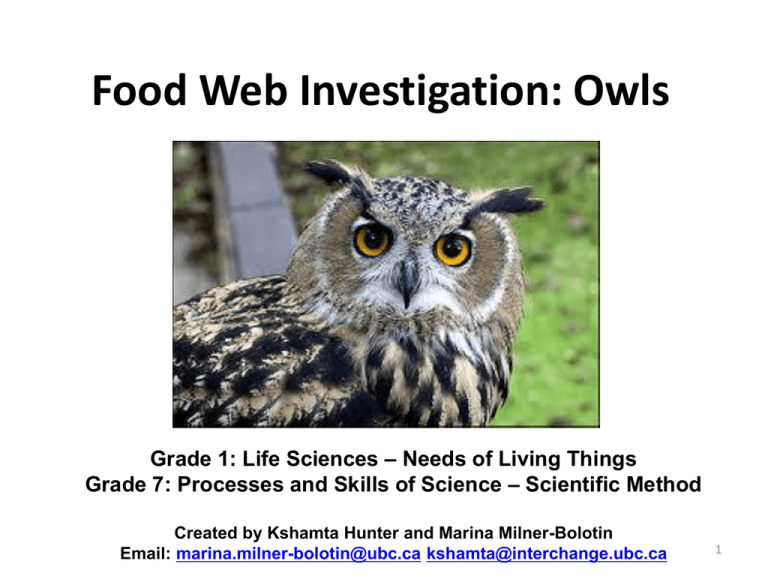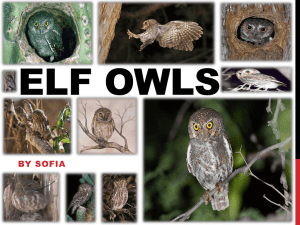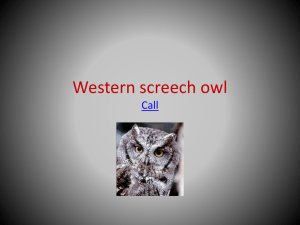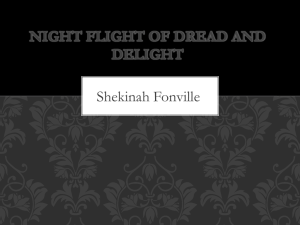
Food Web Investigation: Owls
Grade 1: Life Sciences – Needs of Living Things
Grade 7: Processes and Skills of Science – Scientific Method
Created by Kshamta Hunter and Marina Milner-Bolotin
Email: marina.milner-bolotin@ubc.ca kshamta@interchange.ubc.ca
1
Owls in a Movie!
Legend of The Guardians : The Owls of Ga Hoole
2
Q1: Myth or Fact?
Owls do not drink water.
A. True
B. False
3
Owls in Children’s Books
Owls in children's books in
different cultures! Are
owls wise?
4
Owls in Children’s Books
5
Modified Jigsaw Collaborative
Group Activity
Each group has information on one owl (1 card):
1)
2)
3)
4)
Simplify – synthesize your info
Share the information among all groups
Build owl classification based on what you found
Share your classification with others
6
Group 1: Barn Owls
These pale, nearly worldwide, birds are
closely associated with man through their
traditional use in the Old World of barn lofts
and church steeples as nesting sites. The
species name "alba" also refers to the
colour white.
Habits: Generally nocturnal, although it is
not uncommon to see this species emerge
at dusk or be active at dawn, occasionally
being seen in flight during full daylight. Flight
is noiseless, with wing beats interrupted by
gliding.
7
Group 2: Screech Owl
The Western Screech Owl is a small,
nocturnal, woodland Owl of western
North America and is one of the
west's more common Owls at lower
elevations.
Habits: Nocturnal, with activity
generally beginning 20-30 minutes
after sunset. Flight is noiseless with
soft wing beats and gliding. Will
become motionless if disturbed at
roost, and can sometimes be caught
by hand in this state. This owl is very
aggressive when defending a nest
site, and may attack humans.
Group 3:The Great Horned Owl
Great Horned Owls can vary in colour from a
reddish brown to a grey or black and white. The
underside is a light grey with dark bars and a
white band of feathers on the upper breast.
They have large, staring yellow-orange eyes,
bordered in most races by an orange-buff facial
disc. The name is derived from tufts of feathers
that appear to be "horns" which are sometimes
referred to as "ear tufts" but have nothing to do
with hearing at all.
Habits: Activity generally begins at dusk, but
in some regions, may be seen in late afternoon
or early morning. Both sexes may be very
aggressive towards intruders when nesting.
9
Group 4: Snowy Owl
The Snowy Owl is a large, diurnal white Owl
that has a rounded head, yellow eyes and
black bill. The feet are heavily feathered. A
distinctive white Owl, their overall plumage is
variably barred or speckled with thin, black,
horizontal bars or spots. Intensity of dark
spotting varies with the sex of the immature
females being the darkest. Juveniles are
uniformly brown with scattered white tips of
down.
Habits: Snowy Owls are active during the
daytime, from dawn to dusk. They make short
flights, close to the ground, from perch to
perch, and usually perches on the ground or a
low post. During hot weather, they can thermoregulate by panting and spreading their wings.
Snowy Owls are very aggressive when
10
defending their nest.
Scientific Owl Classification
•
•
•
•
•
•
Kingdom: Animalia
Phylum: Chordata
Subphylum: Vertebrata
Class: Aves
Order: Strigiformes
Family Tytonidae (barn and bay owls) and
Strigidae (other owls)
11
Q2: Owl Vocabulary (Fun Fact)
Owls are typically solitary birds.
However, a group of owls is called a:
A.
B.
C.
D.
E.
Hound
Colony
Troop
Parliament
Flock
Barred Owl
12
The Food Web Group Activity:
Where do Owls Belong?
Quaternary Consumer
Tertiary Consumer
Secondary consumer
Primary consumer
Primary Producer
14
What do the Words Autotrophs
and Heterotrophs mean?
Trophs
Nourish
Auto
Hetero
Self
Other, different
Does your answer make sense?
Trophs
Nourish
Auto
An organism capable of
synthesizing its own food
from inorganic substances
Hetero
An organism that relies
on organic substances
for nourishment
Where do Owls belong?
17
Q3: The Food Web
Which trophic level do owls have on the food web?
A.
B.
C.
D.
Primary
Secondary
Tertiary
Quaternary
Baby Owls
18
Q4: Predator-Prey
Do owls have any natural
predators?
A. Yes
B. No
C. Don’t know
Night Owl
19
Q5: Predator-Prey
In your view, how is the population of the top
predators/consumers controlled?
A. Too much competition within these animals for
food
B. These animals are not able to hunt very well due
to their size
C. There is a dynamic equilibrium that exists
between predator-prey populations
20
Predator-prey population Equilibrium
Predators control the prey population by feeding
on them, however if they eat too much of the
prey, a decline in the prey population will also
subsequently decrease the predator population.
When the predator population declines, the
prey population expands. Therefore a dynamic
equilibrium exists between the two populations.
21
Energy at trophic levels
Energy is lost at each trophic level at each consumption!
22
Homework Ideas
23
The FOOD WEB
Tertiary consumer
Creating a
Food Web
Diagram
Secondary consumer
Primary consumer
Producers 24
Create Your Own Owl Puzzle
•
•
•
•
•
•
•
•
•
•
•
Food web
Heterotrophs
Autotrophs
Primary consumer
Primary producer
Secondary consumer
Tertiary consumer
Quaternary consumer
Ecological pyramid
Energy
Diurnal
•
•
•
•
•
•
•
•
•
•
•
Population
Equilibrium
Dynamic equilibrium
Stable equilibrium
Dynamic Equilibrium
Parliament
Barn own…
Owl pellet
Prey
Predator
Nocturnal…
25
Online Puzzlemaker
26
Vocabulary Games
27
Owl Concept Map
28
Virtual Owl Pellet Dissection
29
Part II: Owls Hands-On Activity – Dissecting an
Owl Pellet
30
Investigation Activity P.E.O.E.:
What do owls eat?
• Hypothesis
– Owls eat _____________
• Experiment
– Examine Owl’s regurgitated pellet
• Data Collection
– Investigate the bones, hair,
feathers, nails, etc…
• Conclusion
– Was your hypothesis correct?
31
Snowy Owl from Zurich
Interesting Fact!
Pygmy Owl and
other owls have
pretty expressive
body language if
they are excited
or alarmed
32
Silent Killer
Owls' Silent Flight May Inspire Quiet Aircraft Tech
–
http://news.nationalgeographic.com/news/2004/12/1217_041217_owl_feathers.html
Reasons for silent flight:
– primary feathers on the owls' wings are serrated like a comb
– the trailing feathers on the back end of the wing are
tattered like the fringe of a scarf
– the rest of the owls' wings and legs are covered in velvety
down feathers
33
Owls in Pictures
34











